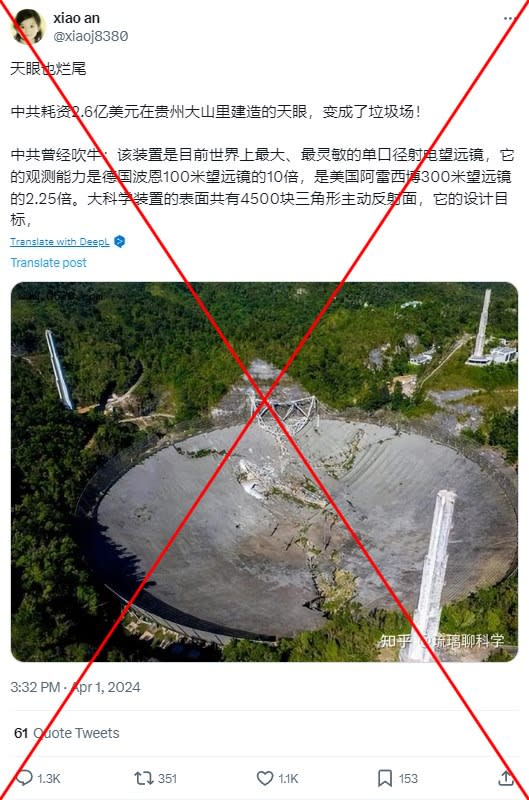Photo shows collapsed Arecibo Observatory in Puerto Rico, not China's 'Eye of Heaven' telescope
A photo of a collapsed radio telescope at Puerto Rico's Arecibo Observatory has been shared hundreds of times alongside false claims it showed an "unfinished" space observation project in southwestern China. But the Five-hundred-metre Aperture Spherical Telescope (FAST) -- dubbed the "Eye of Heaven" -- in Guizhou province in fact started full operations in 2020 and continues to collect radio signals emitted by celestial bodies.
"Even the Eye of Heaven has become an unfinished project," read part of the simplified Chinese caption to a photo shared on social media platform X on April 1, 2024.
"Built by China's Communist Party at a cost of US$260 million in the mountains of Guizhou, it is now just a garbage dump!"

The post is referring to the Five-hundred-metre Aperture Spherical radio telescope (FAST) -- dubbed the "Eye of Heaven" by Chinese state media -- which is nestled among the mountains of China's southwestern Guizhou province (archived link).
Thousands of villagers were displaced to make room for its giant satellite dish, which cost 1.1 billion yuan ($175 million) to build and is easily the world's largest.
The same image was shared alongside similar claims on X here and Instagram here.
But the photo in fact shows damage to the Arecibo Observatory telescope in Puerto Rico.
Arecibo Observatory
A reverse image search on Google and subsequent keyword searches found the image in the false posts is an AFP photo taken on December 1, 2020.
It is captioned: "This aerial view shows the damage at the Arecibo Observatory after one of the main cables holding the receiver broke in Arecibo, Puerto Rico, on December 1, 2020.
"The radio telescope in Puerto Rico, which once starred in a James Bond film, collapsed Tuesday when its 900-ton receiver platform fell 450 feet (140 meters) and smashed onto the radio dish below."
Below is a screenshot comparison between the picture used in the false posts (left) and the AFP photo (right):

The structure collapsed just after engineers warned it was in a decrepit condition, while its owner, the US National Science Foundation (NSF) had announced the month before that it would be dismantled, AFP reported at the time.
The telescope was one of the largest in the world and had been a tool for many astronomical discoveries since the 1960s, as well as being famous for its dramatic scale and setting.
Scientific American reported the site was closed on August 14, 2023, months after the NSF said it would not rebuild the telescope (archived link).
The damage to the satellite dish can be seen on Google Maps satellite imagery of the Arecibo Observatory here (archived link).
Meanwhile, China's FAST, which began running in 2011 and started full operations in January 2020, continues to function and updates of the data it collects can be seen on its official website (archived link).
The gigantic telescope mainly works to capture radio signals emitted by celestial bodies, in particular pulsars -- rapidly rotating dead stars.

